When after five years of construction of the Grossglockner High Alpine Road
in the year 1935 had been opened as a link between north and south of Middle Europe , the high
society of the Austrian motor sport had given a powerful demonstration of its presence. The first
international Großglockner race took place on 4th August 1935, only one day after the official
opening of the road. Still two further races should follow in 1938 and 1939;
they had been named according to the political development “Großer Bergpreis von
Deutschland” (hillclimbing Grand Prix of Germany).
Despite political problems many foreign racing drivers and riders
participated in this first race 1935: With their automobiles came Tadini,
Ballestrero, Pintacuda, Strazza and Villoresi from Italy; Hans Kessler, Max
Christen and Christian Kautz from the Switzerland; Zanelli came from Spain,
Bruno Sojka and the brothers George and Zdenek Pohl as well as engineer
Proskowetz from Czechoslovakia; from England Richard Seaman and Thomas Clarkes,
from the Netherlands Cornelius and Herkuleyns, from Belgium Cocagne, from France
Pierre Rey and Comte de Bremond, and finally from Hungary the drivers Wilheim
and Delmar.
The Austrian participation among the automobiles was slight, from
Germany had been come the hillclimbing specialists Bobby Kohlrausch with
its 750-cm³-Kompresor-MG, Rudolf Steinweg and Walter Bäumer. The very opposite
situation with the motor cycle riders: there the Austrians placed the bulk with
the hill-climb-racing-experienced Martin Schneeweiß, Michael Geyer, Hermann
Deimel and Otto Steinfellner leading the team, while only a few foreigners had
entered for the motor cycle competition. From Switzerland had come the two NSU
specialists Hans Stärkle with his wife in the sidecar and Hans Kaufmann, from
Italy Radames Bianchi, from Hungary Gyula Patho and from Germany Schnitzelbaumer
from Munich.
On the 19,5 kilometres long race course of rolled sand, which had
been still wet with rain at the beginning, the 250 cm³ motor cycle class was won
by the Italian Bianchi on his Miller Balsamo (actual Ludwig Zangerl, Salzburg on
Rudge had been the fastest but he had been disqualified for rule breaking); in
the 350 cm³ class the Viennese Hermann Deimel on Velocette won on an average of
72,7 km/h speed; in the half litre class Michael Gayer, likewise a Viennese, was on his work Husqvarna two
cylinder successful and came on an average speed of 75,4 km/h. The fastest motor
cycle time completed by Martin Schneeweiss, who was not specialized yet at that
time on speedway racing, likewise of Vienna, in the class over 500 cc. With his
Austro Omega (600 cm³ JAP engine) he speeded up on the average of 76,5 km/h,
which corresponded to a time of 15:17,57. The sidecar class had been
dominated by Hans Stärkle on NSU with an average speed of 70,8 km/h.
With automobiles succeeded the best sports car time to the Italian
Carlo Pintacuda, whose Alfa Romeo from the Scuderia Ferrari made an average
speed of 76,7 km/h (15:15,69 min.), only scarcely two seconds faster than the
fastest motor cycle rider. The highlight of the racing cars was the race of
Mario Tadini, who shot up with his Alfa, likewise from the Scuderia Ferrari, in
a time of 14:42,74 min. (79,58 km/h).
Despite the absence of, at that time at the focus of the general
interest, Auto Union and Daimler Benz, the Grossglockner Race 1935 was a
brilliant event. The meetings followed in 1938 and 1939 indeed brought the large
work racing stables to the Grossglockner Road, but the atmosphere were strongly
impaired by bad weather conditions. Also the numbers of entries remained in a
modest scale. Hillclimbing champion Hans Stuck on Auto Union, Hermann Lang
on Mercedes and Manfred von Brauchitsch participated with their automobiles,
Ewald Kluge on DKW, Leonhard Fassl on NSU lined up at the start beside many
other participants of the first race from 1935. The Second World War broke out a
little later and the Grossglockner never again was conquered in race speed. In
1939 the Austrian motor cycle rider Martin Schneeweiss won the 250 cc class on
DKW and Leonhard Fassl was the fastest in the 350 cc class on NSU. By the way,
in 1938 they had intended to start at Fusch down in the Saalach-valley and have a
33,5 km ride up to the Franz-Josef-Height in 2 346 m above sea level. Only bad
weather conditions prevented that adventure for engines and finally finish was
at the "Fuscher Törl".
Today the regular traffic has become too much dense than one could
close this road for a weekend. Also the safety requirements would not have to be
brought in harmony with the conditions to be found along the road.
But the great competitions taken place at this famous race course should not
fall into oblivion. As early as 1985, on the occasion of the fiftieth
anniversary of the existence of the road, it came again to a meeting of motor
sport enthusiasts at the Grossglockner: about 100 automobiles and motor
cycles from the time before 1940 ago met there. For example Hans Hermann
with the Mercedes W 196, Silver arrow, joined the meeting. And of course
Professor Dr.
Helmut Krackowizer came and was highly pleased about reviving
of an old past time - despite the bad weather.
Then, after his death, in 2002, 2004 and 2006 in memory of Helmut Krackowizer,
regularity competitions for historic racing motorcycles took place on this road.
And once again racing engines roared: from 2012 to 2017 the "Großglockner Grand Prix"
for historic racing cars took place. Then motorsport on the Großglockner High Alpine Road
fell silent again.
"Conquerors of the summit" at the Grossglockner
Posted December 2012 by Peter
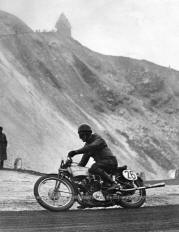
Michael Gayer 1935
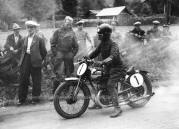
Maria Wachter, 1935, Puch
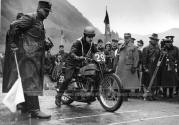
Roigk on Husqvarna 1938
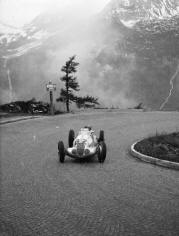
Hermann Lang, 1938,
Mercedes Benz
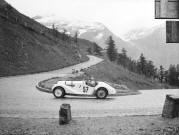
Eckhardt Graf von der Mühle,
1938, BMW
in the sportcar class
not supercharged (Q1)
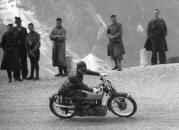
Martin Schneeweiß, 1939, DKW
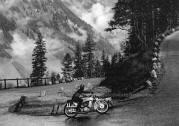
Walfried Winkler, 1938, DKW








